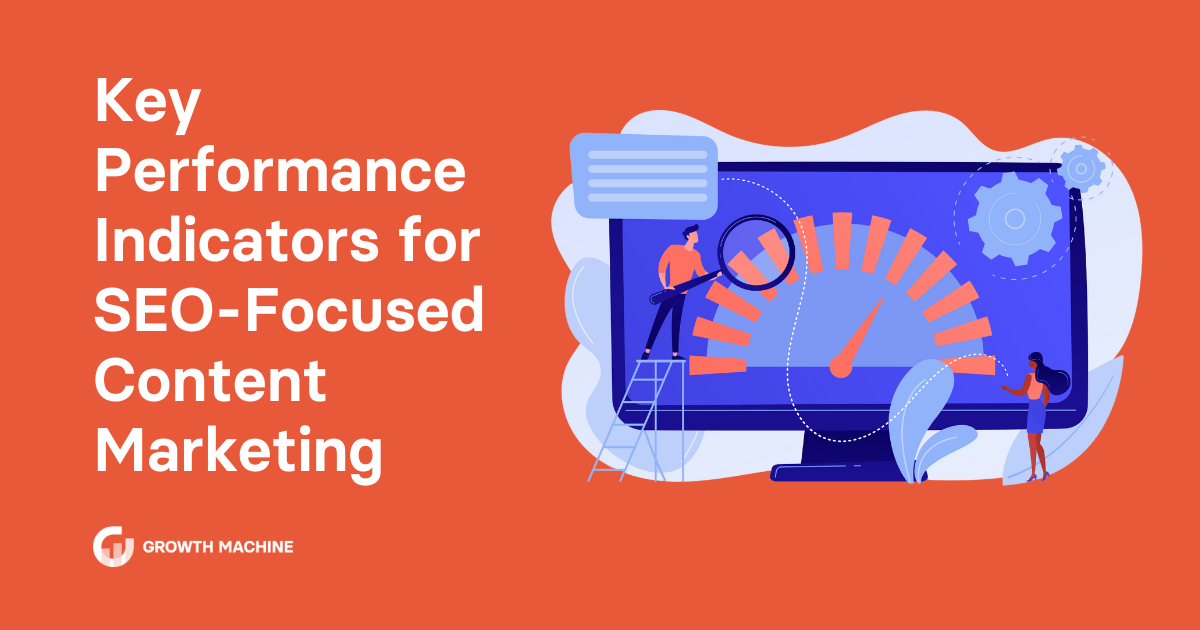Key Performance Indicators for SEO-Focused Content Marketing
One of the biggest challenges with SEO is getting a good sense of how well you’re doing, especially when you’re just starting out.
Depending on your site’s domain authority, it might take anywhere from three to six months for search engines to serve your content and for new articles to bring in organic traffic. Without waiting six months, how can you determine if your strategy is moving the dial and your website is gaining traction in search engines?
In this article, we’ll walk you through the four most important SEO metrics we use to gauge the success of each of our content marketing strategies, the tools we use to track these metrics, and key indicators that a strategic shift is needed.
What Is an SEO KPI?
Before we can teach you what and how to track your SEO campaigns, it’s important to understand exactly what an SEO key performance indicator (KPI) is. SEO KPIs are the metrics measured to gauge the success (or failure) of an SEO strategy and a website’s organic search results performance.
While increased organic traffic to the site is an obvious indication of success, you can gauge your site’s success and make critical adjustments to your strategy early on by paying attention to a number of early indicators that appear long before you start to see noticeable changes in traffic.
Let’s dive into these metrics and see how they can impact your site.
4 Key Metrics to Measure the Success of Your SEO Efforts:
- Impressions: the number of times Google serves your article or site in a search engine results page (SERP)
- Click-Through Rate (also known as CTR): the number of users who click through to your site from a SERP
- Search Rankings (also known as keyword rankings): the position, or rank, that your page holds for the particular search queries
- Organic Traffic: the number of visitors who land on your site organically, not from a paid source or ad
In digital marketing, the ability to pivot and adapt your strategy is vital to its success. Since we typically can’t count on organic traffic to indicate SEO success early in a program, we use each of these important metrics, at different times in a website’s lifecycle, to track progress.
Here’s when and how we track them.
Impressions
During the first few months of a new content marketing program, we look for a steady increase in impressions to indicate that our SEO efforts are building a solid foundation for future ranking success.
An impression is recorded each time Google displays any of your site’s pages in a SERP (search engine results page) for a specific search query or target keyword. Impressions are a vital KPI to track because it indicates that Google recognizes your search engine optimization efforts and is rewarding those efforts by serving up your content to searchers.
Before we begin to see clicks and traffic to these articles, we first need Google to register the new content and serve it to the appropriate target audience. An increase in impressions indicates that Google recognizes your site as an increasingly reliable voice in its category, and is serving your articles more frequently as a way to continually verify the quality and utility of your content to searchers.
If you do not see an increase in impressions in the first two to three months of publishing, this is an indication that either something is technically wrong with your site, or that your content marketing strategy is misaligned with what Google thinks your site is an authority on. If users are clicking through to your article and quickly “bouncing” (clicking back to the search results page), this is an indication to Google that your article isn’t effectively addressing the search query, and your article will start to slowly lose ranking.
If you find yourself in a situation where you’re not seeing impressions increase in the first one or two months of publishing, we suggest making some adjustments to your content strategy. Some questions to consider are: Are the keywords I’m targeting relevant to my products and/or services? Are the articles I’m writing answering the search queries? If you’re unsure, take a look at the articles that are currently ranking #1-3 for those keywords to better understand what Google (and the searcher) is looking for.
Click-Through Rate
Click-through rate is another early indication of your site’s SEO performance, which you’ll start to see emerge by month 4. CTR is calculated by dividing the number of clicks your site receives by number of impressions, or, in other words, the percentage of searchers who clicked on your site from a search engine results page.
CTR is an incredibly valuable gauge of the effectiveness of your title tags and meta descriptions on user engagement. When written well, on-page SEO components like these can have a massive impact not only on CTR, but other metrics like rankings.
If you’re noticing a very low CTR, or seeing an increase in impressions while CTR decreases or remains stagnant, it might be worth considering how you can more effectively grab searchers’ attention with meta description and title tag optimization, improving your site’s organic search visibility.

This photo shows a snippet of a search engine results page for the search term “key differentiator,” for which Growth Machine is ranked third on Google.
These SEO components are often the first opportunity that you have to engage with or make an impression on a potential customer, and have the potential to greatly impact CTR. Compelling or interesting title tags and meta descriptions are more likely to engage users, resulting in a higher CTR. Conversely, uninteresting or unclear tags and descriptions will likely result in a low CTR.
While understanding click-through rate is simple, determining whether or not your site’s CTR is good can be a little bit trickier. The average CTR varies by ranking position, and evaluating your site’s CTRs is helpful in determining how valuable each position is to your site.
When you find that the CTR for a particular keyword, or for the bulk of your keywords, is much lower than you’d expect, you’ve found an opportunity to shift something in your SEO strategy and improve these articles and your project as a whole.
Oftentimes, when this is the case, it’s because the articles you’re writing aren’t actually answering or addressing the search query. Again, do a little research to better understand how competitor articles are addressing the query and what information your article is lacking, and shift accordingly.
Search Rankings
In the early stages in an SEO strategy, without organic traffic (yet) to gauge the project’s success, we look to rankings.
At this point, we’re less concerned with ranking position, but rather ranking movement, or whether new articles are first emerging with a position within the top 100 rankings, then gradually rising.
For example, this Growth Machine client is in month 2 of publishing, and already seeing consistent ranking growth across each of the keywords we’ve published:

While they’ve seen some small increases in organic traffic to the site (a rising tide lifts all ships!), none of this new traffic is to the new articles we’ve published. Until these articles are positioned on the first page of Google, we don’t expect to see them contributing to traffic growth.
Each of these keyword phrases in the left column represents an article we’ve recently published to the blog. On the right side, you can see where they’re currently ranked, and their initial rank.
“Not in the top 100” means that the blog site wasn’t previously ranking on Google SERPs for any of these key phrases, but you can clearly see now that they’re quickly (some of these articles were published in the last few weeks!) climbing in rank toward page 1.
To get a clear picture of the effectiveness of your SEO strategy, monitor these rankings, week over week, making sure they continue to show movement toward Google’s first page.
If you’re still not seeing ranking progress three to four months into publishing, this is an indication that something isn’t quite right.
Keeping an eye on ranking progress is vital to understanding the performance of a new SEO endeavor and an effective way to spot problems in your strategy early on.
Organic Traffic
Organic traffic is a measure of all visitors to your site from organic search. This is the most obvious SEO KPI, but generally speaking, the slowest to materialize.
Here are a couple considerations to keep in mind when measuring this SEO metric:
- Measure your site’s traffic weekly and monthly instead of daily. Measuring longer time frames paints a more accurate picture of your project’s success and allows you to identify trends and not get distracted by anomalies.
- As your site ages, leverage the compare feature in your Google Analytics account to identify month over month, quarter over quarter, and year over year trends and use that data to inform strategic shifts to your content marketing (and digital marketing) efforts.
Daily fluctuations can be pretty substantial based on people’s online behaviors from one day to the next. For example, on weekdays people tend to spend a lot more time online, as they’re likely already sitting at a computer for work. Conversely, weekends tend to see less search behavior and an increase in social media activity with the majority of people off for the weekend.
Additionally, seasonality is another behavioral trend that often impacts search volume and traffic on a larger scale that can be more easily pinpointed when looking at a longer time frame in traffic monitoring. For example, health and wellness and personal finance industries tend to see a spike in traffic in the first quarter of each year, as people make resolutions and seek to improve these categories of their lives.
Take a look at the graph below. When looking at the daily traffic over the last week, very little can be learned by focusing on the day-to-day fluctuations over a one-week time frame.

Looking at the graph below, you’ll notice that when you monitor organic traffic over a longer time frame, you can more effectively identify trends.

But when you zoom out over several months, focusing on weekly traffic instead of daily, you can more effectively identify trends and see a clearer picture of your SEO strategy’s performance.
Organic search traffic growth is THE SEO KPI that we’re aiming to improve, and the overall goal of content marketing. Each of the other KPIs we measure are early indicators that we’re heading in the right direction before we see the traffic growth we’re ultimately aiming for.
Tools for Tracking SEO Strategy
So how do you track your SEO KPIs? Our favorite tools make it simple, and in many cases, free!
Google Analytics and Google Search Console are the first tools you should set up once you build a new site, start a new SEO strategy, or otherwise need to begin tracking SEO KPIs. In these dashboards, you can gauge the success of your digital marketing strategies, both paid and organic. And, equally importantly, you can use these tools to determine return on investment, or ROI.
Early in your SEO strategy, you can leverage Google Search Console (GSC) to track impressions and click-through rate. In the left-hand menu, select “search results” and both of these metrics are displayed in an easy-to-read graph.
In GSC, you can also see which search queries and pages are performing best in impressions and CTR, which is useful in informing your strategy and planning for strategic shifts.
In Google Analytics (GA), you can monitor organic sessions to your blog or full site, both paid and organic. As we mentioned, there are a number of great ways to track your growth and identify trends and seasonalities, all of which can be done here.
In GA, you can see your traffic in a big picture, and a granular level. You can monitor traffic to the site or blog as a whole, or home in on specific webpages of your blog to see how much traffic you’re driving for articles ranked in the top three, or just on page 1 of Google.
You can also use these tools to monitor valuable metrics such as page views, bounce rate, conversion rates, average time spent on page, number of pages visited, and other user engagement metrics. While these aren’t the main SEO KPIs we track in the early stages of a content marketing project, they’re still useful insights for understanding the impact of your strategy and spotting potential flaws.
Ahrefs is the SEO tool we use to monitor keyword rankings to clients’ sites as well as our own.
In Ahrefs, you can track the main keyword you’re targeting in each article, as well as see the total number of keywords an article is ranking for. You can monitor MoM changes to the full scope of rankings for your website and blog, or even to individual landing pages.
This tool is also vital to keyword research and the planning process in your SEO strategy, offering competitor data on specific keywords and rankings, as well as full site data.
You can utilize Ahrefs to perform gap analysis between your site and others in your industry and online space. In your dashboard, you can see changes to traffic, organic keywords, number of backlinks, and domain rating, all of which are useful metrics in adding context to the performance of your content marketing strategy.
If you’re comparing tools to see which might be the best fit for your business goals, pricing needs, and overall user experience, you should also consider Semrush and Moz as well. Similar to Ahrefs, both of these tools offer a number of features that help users measure the performance of their digital marketing efforts.
Bonus Tools:
While not explicitly SEO KPIs, it’s important to understand a handful of other ranking factors in order to set your site up for success.
We briefly mentioned technical SEO earlier and its effect on search rankings. You could execute the perfect on-page SEO strategy, but if your site’s technical SEO isn’t properly set up, your efforts are a waste of time and energy.
While a professional technical audit of your site is the most thorough way to ensure your site is properly set up, there are a number of things you can do on your own before getting started with your content marketing efforts.
In GSC, you can submit your sitemap to Google, showing which pages are currently on your site, and helping search engines to crawl and index them.
Another vital metric to your site’s performance is page speed and page load time, and you can see and improve your page speed insights using this free tool.
Additionally, you should check your site’s core web vitals using this tool. Google’s CWV measures a handful of factors specific to user experience and rates your site accordingly. This report not only shows you how your site measures up, but also provides specific instructions for fixing any errors found.
Making sure your site’s technical SEO is properly set up should be a step taken prior to launching any digital marketing campaign, but especially SEO.
Time to Start Tracking Your SEO KPIs
If you’re not already tracking these metrics, now is the time to set it up. The sooner you start watching these metrics, the sooner you’ll be able to get a better sense for what is and isn’t working, and shift your strategy accordingly.
If the idea of strategizing, analyzing, and executing has your head spinning, contact us and let’s talk about what it might look like to have us plan, execute, and monitor an SEO strategy for you.







